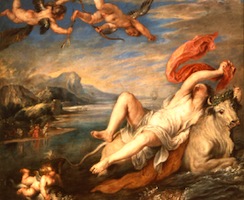
First International Conference of Hermeneutical Studies on Symbol, Myth and “Modernity of Antiquity” in Italian Literature and Arts from the Renaissance to the twenty-first Century
Milan, Università Cattolica del Sacro Cuore, 1-2 December 2015
PANELS
I. Words and concepts
I. 1. Hermeneutics, symbol and myth: etymological meaning of the terms and their evolution in the ancient culture.
II. Symbol and myth in early Catholicism
II. 1. Symbol in early Catholicism and liturgy.
II. 2. Symbols and myths of paganism, with particular reference to the mystery cults, in the interpretation of the Fathers of the Church, the Christian Apologists and ancient Christian writers (i.e. Clement of Alexandria, Arnobius, Firmicus Maternus, Augustine of Hippo).
III. The religious meaning of mythological symbol, myth and new syncretistic and apocalyptic mythology in some anticlassical theories of the modern age
III. 1. Symbolik und Mythologie der alten Völker, besonders der Griechen di Georg Friedrich Creuzer (Marburg an der Lahn, 1771 – Heidelberg, 1858).
III. 2. L’Abrégé de l’Origine de tous les Cultes di Charles François Dupuis (Trie-Château, 1742 – Is-sur-Tille, 1809).
III. 3. Le Gottheiten von Samothrake e la Philosophie der Offenbarung di Friedrich W. J. Schelling (Leonberg, Württemberg, 1775 – Bad Ragaz, Sankt Gallen, 1854).
IV. Crypto-pagan symbols and themes hidden “under the veil” of Italian literature and the arts: symbols, myths and themes of the “modernity of antiquity” from the Renaissance to the twenty-first century
IV. 1. «Ut pictura poësis». Crypto-pagan symbolism and themes covered “under the veil” of the images of the Italian literature and the arts (from Renaissance to the twenty-first century), analyzed on the basis of ancient sources (both literary and mythological-religious) functioning as hypotexts or hypertexts. The symbols and themes must refer to archaic, pre-Homeric, non-Olympic or even anti-Olympic ancient religious systems, or to ancient mystery cults, either Mediterranean or non Mediterranean.
Other main themes and figures that can be analyzed (even from a comparative and mythological-religious perspective, if necessary) include: Bacchus (-Dyonisus-Zagreus-Sabatius-Jacchus; Orpheus); Venus (-Aphrodite; Astarte; Tanit-Ishtar); Adonis (-Tammuz);Isis, Osiris, Horus; Saturn (Cronus, Moloch, Baal Hammon; Aion, Zervan). Papers on crypto-pagan symbols referring to apocalyptic themes will be accepted as well.
Essential bibliography: Le religioni dei misteri, vol. I: Eleusi, Dionisismo, Orfismo, vol. II: Samotracia, Andania, Iside, Cibele e Attis, mitraismo, a cura di Paolo Scarpi, Fondazione Lorenzo Valla / Arnoldo Mondadori Editore, 2002-2003; I culti orientali nell’Impero Romano. Un’antologia di fonti, a c. di Ennio Sanzi, Cosenza, Giordano, 2003; Edgar Wind, Pagan Mysteries in the Renaissance, Oxford University Press, 1980 (tr. it. Misteri pagani nel Rinascimento, Milano, Adelphi, 1999); Manfred Frank, Der kommende Gott. Vorlesungen über die Neue Mythologie, Frankfurt am Main, Suhrkamp Verlag, 1982 (tr. it. Il dio a venire. Lezioni sulla Nuova Mitologia, Torino, Einaudi, 1994).
IV. 2. Traces of ancient Christian and Jewish heresies and of the Jewish crypto-paganism hidden “under the veil” of the images, of the symbols and of the themes of Italian literature from the Renaissance to the twenty-first century.
IV. 3. Traces of crypto-esoteric initiation and crypto-pagan symbolism hidden “under the veil” of the narrative of Jules Verne (Nantes, 1828 – Amiens, 1905) and Maurice Leblanc (Rouen, 1864 – Perpignan, 1941), and in both popular and highbrow Italian literature and arts.
IV. 4. The crypto-paganism of the “Ancients” in the works of Lord Dunsany (London, 1878 – Dublin, 1957), Arthur Machen (Caerleon-on-Usk, Monmouthshire, 1863 – Beaconsfield, Buckinghamshire, 1947) and Howard Phillips Lovecraft (Providence, Rhode Island, USA, 1890-1937) in Italian literature and arts.
IV. 5. Themes and symbols of ancient paganism (mystery cults, Mediterranean and non Mediterranean) in historical-esoteric Italian thrillers.
IV. 6. The “modernity of antiquity” in the symbols and mythological and crypto-pagan themes of the twentieth and twenty-first century’s comics, cartoons and video games.
TERMS OF PARTICIPATION
Languages: Italian, English, French and Spanish.
All the participation proposals (POSTER or SPEECH) must be sent via email to the Scientific Secretary by November, 10 together with the following two attachments:
File n. 1: a pdf file including ONLY the title and the abstract of the proposal; 10 key words WITHOUT any personal details; the number of the panel the proposal is referring to.
File n.2: a pdf containing, apart from the title of the speech or poster, the abstract (1000 characters, spaces included), 10 keys words and the number of the panel the proposal is referring to (see file 1), also the following information: first name, last name, citizenship, residence, passport; title University and academic position (full professor, associate professor, researcher, aggregate professor; PhD student, grant researcher; laboratory teacher; assistant).
Freelance researchers (MA and PhD) will have to add the title of the PhD and Degree and the University they attended; the title of their thesis and the name of their tutor/s; their current job position and their job experiences.
The subject line of the email, the title of file n.1 and 2 must all contain the number and the title of the panel to which the proposal belongs.
Please note that the conference accepts proposals in Italian, English, French and Spanish.
The communication regarding the accepted proposals (both speech and poster) will be sent by November, 15.
Proposals need to analyze myth and symbols from the perspective of the “modernity of antiquity”. This perspective requires to take into account the available philological and historical resources and to focus on the identification of ancient literary and religious sources of myth and mythological symbol related to forms of archaic, pre-Homeric, non-Olympic or ancient mystery pagan religions, both Mediterranean and non Mediterranean, but neither Homeric nor Olympic. The purpose to device new strategies for deciphering the deepest meaning of literary and art works conceived from the perspective of the “modernity of antiquity” and with a multilayered semantic structure. For further information on the “modernity of antiquity”, the panels and the program, please contact: ida.villa@unicatt.it,bart.vandenbossche@arts.kuleuven.be
Detailed information on registration will be communicated later on.
Papers that are accepted for the conference will be susequently published in a book.
http://docenti.unicatt.it/ita/angela_ida_villa

Leave a Reply
You must be logged in to post a comment.